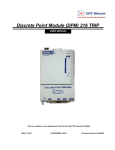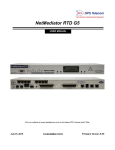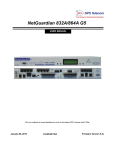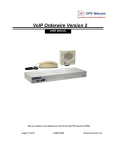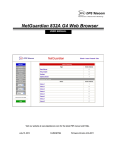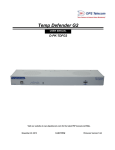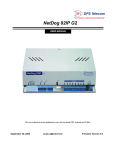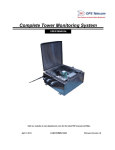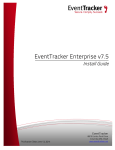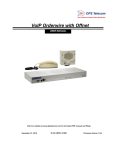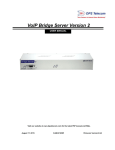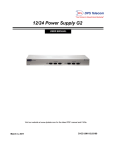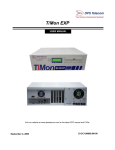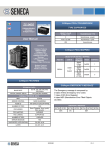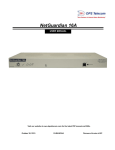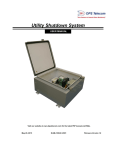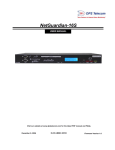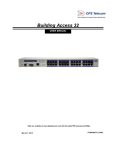Download Trap 48 RA - DPS Telecom
Transcript
Trap 48 RA USER MANUAL Visit our website at www.dpstelecom.com for the latest PDF manual and FAQs. December 16, 2013 D-UM-TRAPR Firmware Version 1.0A Revision History December 16, 2013 Added play cound and parse to Edit>Audio screen July 25, 2013 Removed HTTPS January 21, 2013 Added relay specification option to Edit>Audio menu December 12, 2012 Initial release This document contains proprietary information which is protected by copyright. All rights are reserved. No part of this document may be photocopied without prior written consent of DPS Telecom. All software and manuals are copyrighted by DPS Telecom. Said software and manuals may not be reproduced, copied, transmitted or used to make a derivative work, by either mechanical, electronic or any other means in whole or in part, without prior written consent from DPS Telecom, except as required by United States copyright laws. © 2013 DPS Telecom Notice The material in this manual is for information purposes and is subject to change without notice. DPS Telecom shall not be liable for errors contained herein or consequential damages in connection with the furnishing, performance, or use of this manual. Contents Visit our w ebsite at w w w .dpstele.com for the latest PDF m anual and FAQs 1 Trap 48 RA Overview 1 2 Specifications 3 3 Shipping List 4 4 Installation 6 4.1 Tools Needed 6 4.2 Mounting 6 5 Trap 48 RA Back Panel 7 5.1 Power Connection 7 5.2 LAN Connection 8 5.3 Relay Outputs RJ-45 Connectors 8 5.4 Audio Output Connectors 6 Trap 48 RA Front Panel 6.1 RJ-45 Console Port 7 Quick Start: How to Connect to the Trap 48 RA 10 11 11 12 7.1 ...via RJ-45 Console Port (using TTY Interface) 12 7.2 ...via LAN (First Time Connection to a Unit at Factory Defaults) 13 8 TTY Interface 14 9 Trap 48 RA Web Browser 15 9.1 Logging on to the Trap 48 RA 9.1.1 Changing the Default Password 10 Trap 48 RA - Quick Turn Up 15 16 17 10.1 How to Configure Trap Parsers for an Output 17 10.2 Useful Tools 19 11 Edit Menu Field Descriptions 20 11.1 System 20 11.2 Ethernet 21 11.3 Controls 22 11.3.1 Configuring Granular OID 23 11.4 Audio 25 11.5 System Alarms 27 11.6 Ping Targets 28 11.7 Notifications 29 11.8 11.7.1 Notification Settings 30 11.7.2 Schedule 31 11.7.3 How to Send Email Notifications 32 Variable Bindings 35 11.9 Date and Time 36 11.10 Timers 37 11.11 Reboot 37 12 Monitoring via the Web Browser 38 12.1 Controls 38 12.2 Audio 39 12.3 Alarms 40 12.4 Ping Targets 40 13 Firmware Upgrade 41 14 Reference Section 42 14.1 Front and Back Panel LEDs 42 14.2 Display Mapping 44 14.3 SNMP Manager Functions 44 14.4 SNMP Granular Trap Packets (Outbound) 45 15 Frequently Asked Questions 47 15.1 General FAQs 47 15.2 SNMP FAQs 48 16 Technical Support 49 17 End User License Agreement 50 1 1 Trap 48 RA Overview Fig. 1.1 The easy-to-install Trap 48 RA operates up to 48 relays and 16 audio outputs Overview The Trap 48 RA is a device that operates up to 48 relays and 16 audio outputs using received SNMP trap information. The user can configure each relay to operate or release based on the enterprise, generic-trap, and specific-trap information of a SNMP v1 trap or the trap OID of a SNMP v2c trap. Each SNMP trap can also be defined by an optional variable binding. This telco-grade remote is housed in a durable aluminum chassis that uses one standard rack units for mounting. 48 Relay Outputs 16 Audio Outputs 64 Ping Targets Convenient RJ-45 connectors are used to securely terminate relay and audio outputs On the back panel of the Trap 48 RA, the 28 RJ-45 connectors securely terminate the relay and audio outputs. There are four relays grouped per RJ-45, and one audio per RJ-45 connector. Visual alarm interface The front panel LED indicators provide visual indication of relay point and audio output status. Two outputs share one LED (ex. 1/25, 2/26 etc.). LEDs that are on indicate active outputs. LEDs that are off indicate inactive outputs. 2 Web Browser Interface From the device’s easy-to-use web interface, you do all of the configuration setup tasks like reversing the relay energize state , or selecting audio message, on an individual output basis. Additionally, from the web interface you are able to view the status of all the outputs. 3 2 Specifications Control Relay Outputs: 48 Audio Outputs: 16 DB Range: -25 dBm to 5 dBm Software Selectable (-10 dBm default, 600 Ohm balance pair) Ping Targets: 64 Protocols: Telnet, ICMP, DCPX, SNMPv1, SNMPv2c*, HTTP Dimensions: 1.72" H x 17" W x 7.38" D Weight: 3 lbs 4 oz Mounting: 19" or 23" rack mount Power Input Voltage Options Include: Dual Feed +12 VDC Current Draw: 600 mA @ 12 Vdc 300 mA @ 24 Vdc 150mA @ 48 Vdc GMT Fuse: Interfaces: 1 Amp GMT Fuse (recommended) 28 RJ-45 Ports for Audio/Relay Outputs 1 RJ-45 10BaseT half-duplex Ethernet port 1 RJ-45 Front-panel console RS232 port Visual Interface: 36 Front Panel LEDs 5 Back Panel LEDs Operating Temperature: 32° to 140° F (0° to 60° C) Operating Humidity: 0% to 95% non-condensing MTBF: 60 years Windows Compatibility: Windows XP, Vista, 7 32/64 bit RoHS: 5/6 *The Trap 48 RA can only process inbound SNMP v2c traps; it can't send v2c traps, but can send v1 traps. 4 3 Shipping List Please make sure all of the following items are included with your Trap 48 RA. If parts are missing, or if you ever need to order new parts, please refer to the part numbers listed and call DPS Telecom at 1800-622-3314. Trap 48 RA D-PK-TRAPR Trap 48 RA User Manual D-UM-TRAPR 14 ft. Ethernet Cable D-PR-923-10B-14 6 ft. RJ45 to DB9 Cable D-PR-1051-10A-06 23" Rack Ears D-CS-325-10A-01 19" Rack Ears D-CS-325-10A-00 x8 3/8" Ear Screws and Lock Washers 2-000-60375-05 x4 Rack Screws 1-000-12500-06 5 x4 Alternate Rack Screws 2-820-80750-03 Pads 2-015-00030-00 x3 1 Amp GMT Fuses 2-741-01000-00 x2 Lg. Locking Power Connectors 2-820-35102-00 Keps Nut (on unit) 2-002-01421-00 x4 Zip Ties 1-012-00106-00 6 4 4.1 Installation Tools Needed To install the Trap 48 RA, you'll need the following tools: Phillips No. 2 Screwdriver Small Standard No. 2 Screwdriver PC with terminal emulator, such as HyperTerminal 4.2 Mounting Fig. 4.1 The Trap 48 RA can be flush or rear-mounted The Trap 48 RA occupies one standard rack unit. The Trap 48 RA mounts in a 19" or 23" rack, and can be mounted on the right or left, in the flush-mount or rear mount locations, as shown in Fig. 4.1. The rack ears can be rotated 90° for wall mounting or 180º for other mounting options. Fig. 4.2 Fig. 4.3 7 5 Trap 48 RA Back Panel Fig 5.1 Trap 48 RA back panel connections 5.1 Power Connection The Trap 48 RA is powered by two screw-locking RIA power connectors. Fig. 5.2 The Trap48 RA's power inputs Note: Always use safe power practices when making power connections. Be sure to remove fuses from the fuse distribution panel, as well as the back of the unit, before making your power connections. To connect the unit to a power supply: 1. Use the grounding lug to connect the unit to earth ground. The grounding lug is next to the symbol . 2. Insert the eyelet of the earth ground cable between the two bolts on the grounding lug (Ground cable not included). 3. Insert a battery ground into the power connector plug's right terminal and tighten the screw. 4. Insert a battery lead to the plug's left terminal and tighten its screw. 5. Insert fuse into the fuse distribution panel. 6. Check the power status LED for polarity. (eg. Green = Good, Off = Bad) 7. Measure voltage. Connect the black cable onto the ground connector of your DVM and red cable onto the other connector of your DVM. The voltmeter should read between +12VDC and +18VDC. Note: The voltage range will depend on build and power input source. If you experience any issues with powering your unit, contact DPS Telecom technical support at 559-454-1600 or [email protected] 8. Insert the local fuse into the power fuse slot. The power plug can be inserted into the power connector only one way to ensure the correct polarity. Note: The negative voltage terminal is on the left and the GND terminal is on the right. 9. Verify that the LED is lit. To confirm that power is correctly connected, the front panel status LED will flash RED and GREEN, indicating that the firmware is booting up. 8 5.2 LAN Connection Fig. 5.3 LAN Port To connect the Trap 48 RA to the LAN, insert a standard RJ45 Ethernet cable into the 10BaseT Ethernet port on the back of the unit. If the LAN connection is OK, the LNK LED will illuminate SOLID. 5.3 Relay Outputs RJ-45 Connectors Fig. 5.4 Relay Outputs On the back panel of the Trap 48 RA, the 12 RJ-45 connectors along the top securely terminate the relay outputs. See pinouts below: RLY 1-4 CT 1 CO CT 1 SW CT 2 CO CT 2 SW CT 3 CO CT 3 SW CT 4 CO CT 4 SW RLY 5-8 CT 5 CO CT 5 SW CT 6 CO CT 6 SW CT 7 CO CT 7 SW CT 8 CO CT 8 SW Control Relays 1-16 Pin # RLY 9-12 1 CT 9 CO 2 CT 9 SW 3 CT 10 CO 4 CT 10 SW 5 CT 11 CO 6 CT 11 SW 7 CT 12 CO 8 CT 12 SW Pin # RLY 13-16 1 CT 13 CO 2 CT 13 SW 3 CT 14 CO 4 CT 14 SW 5 CT 15 CO 6 CT 15 SW 7 CT 16 CO 8 CT 16 SW Pin # 1 2 3 4 5 6 7 8 Pin # 1 2 3 4 5 6 7 8 9 Control Relays 17-32 RLY 17-20 Pin # RLY 25-28 CT 17 CO 1 CT 25 CO CT 17 SW 2 CT 25 SW CT 18 CO 3 CT 26 CO CT 18 SW 4 CT 26 SW CT 19 CO 5 CT 27 CO CT 19 SW 6 CT 27 SW CT 20 CO 7 CT 28 CO CT 20 SW 8 CT 28 SW RLY 21-24 Pin # RLY 29-32 CT 21 CO 1 CT 29 CO CT 21 SW 2 CT 29 SW CT 22 CO 3 CT 30 CO CT 22 SW 4 CT 30 SW CT 23 CO 5 CT 31 CO CT 23 SW 6 CT 31 SW CT 24 CO 7 CT 32 CO CT 24 SW 8 CT 32 SW Pin # 1 2 3 4 5 6 7 8 Pin # 1 2 3 4 5 6 7 8 Control Relays 33-48 RLY 33-36 Pin # RLY 41-44 CT 33 CO 1 CT 41 CO CT 33 SW 2 CT 41 SW CT 34 CO 3 CT 42 CO CT 34 SW 4 CT 42 SW CT 35 CO 5 CT 43 CO CT 35 SW 6 CT 43 SW CT 36 CO 7 CT 44 CO CT 36 SW 8 CT 44 SW RLY 37-40 Pin # RLY 45-48 CT 37 CO 1 CT 45 CO CT 37 SW 2 CT 45 SW CT 38 CO 3 CT 46 CO CT 38 SW 4 CT 46 SW CT 39 CO 5 CT 47 CO CT 39 SW 6 CT 47 SW CT 40 CO 7 CT 48 CO CT 40 SW 8 CT 48 SW Pin # 1 2 3 4 5 6 7 8 Pin # 1 2 3 4 5 6 7 8 Fig 5.5 Jumpers The build option determines if jumpers are present. If they are not, the unit will be hand wired for either N/O if N/C on all relays. Check your product number description for your device's configuration. 10 5.4 Audio Output Connectors Fig. 5.6 Audio Outputs On the back panel of the Trap 48 RA, the 16 RJ-45 connectors along the bottom securely terminate the audio outputs. See pinout below: Note: Only pins 1 & 2 are used for the audio outputs' RJ-45 connections. 11 6 Trap 48 RA Front Panel Fig. 6.1 Trap 48 RA front panel 6.1 RJ-45 Console Port Use the front-panel RJ-45 console port to connect the Trap 48 RA to a PC for onsite unit configuration. To connect via the RJ-45 console port, use the included DB9 to RJ-45 cable. Note: The console port is RS232. Fig 6.2 RJ-45 Pinouts (Console Port Only) 12 7 Quick Start: How to Connect to the Trap 48 RA Most Trap 48 RA users find it easiest to give the unit an IP address, subnet and gateway through the front serial console port (TTY interface) to start. Once these settings are saved and you reboot the unit, you can access it over LAN to do the rest of your databasing via the Web Browser interface. Alternative option: You can skip the TTY interface by using a LAN crossover cable directly from your PC to the Trap 48 RA and access its Web Browser. See the "...via LAN" section of this chapter. 7.1 ...via RJ-45 Console Port (using TTY Interface) Fig. 7.1 Trap 48 RA Console Port The simplest way to connect to the Trap 48 RA is over a physical cable connection between your PC's COM port and the Trap 48 RA's console port. Select the following COM port options: • Bits per second: 9600 • Data bits: 8 • Parity: None • Stop bits: 1 • Flow control: None When a connection is established (sometimes accompanied by receipt of a hex byte), press Enter to activate the configuration menu. The default username is "admin" and the default password is "dpstelecom". You can perform basic configuration via the console port - but if you like, you can connect via the console port just to configure the Trap 48 RA's Private LAN IP address, and then do the rest of your configuration via a LAN connection. 13 7.2 ...via LAN (First Time Connection to a Unit at Factory Defaults) Fig 7.2 Connection through Ethernet port To connect to the Trap 48 RA via LAN, all you need is the unit's IP address (Default IP address is 192.168.1.100). If you DON'T have LAN, but DO have physical access to the Trap 48 RA, connect using a LAN crossover cable. NOTE: Newer PCs should be able to use a standard straight-through LAN cable and handle the crossover for you. To do this, you will temporarily change your PC's IP address and subnet mask to match the Trap 48 RA's factory default IP settings. Follow these steps: 1. Get a LAN crossover cable and plug it directly into the Trap 48 RA's LAN port. 2. Look up your PC's current IP address and subnet mask, and write this information down. 3. Reset your PC's IP address to 192.168.1.200. Contact your IT department if you are unsure how to do this. 4. Reset your PC's subnet mask to 255.255.0.0. You may have to reboot your PC to apply your changes. 5. Once the IP address and subnet mask of your computer coincide with the unit, you can access the Trap 48 RA via a Telnet session or via Web browser by using the unit's default IP address of 192.168.1.100. 6. Provision the Trap 48 RA with the appropriate information, then change your computer's IP address and subnet mask back to their original settings. Now you're ready to do the rest of your configuration via LAN. Plug your Trap 48 RA into your LAN and see the "Logging On to the Trap 48 RA" section to continue databasing using the Web Browser. 14 8 TTY Interface The TTY interface is the Trap 48 RA's built-in interface for basic configuration. From the TTY interface, you can: Edit the IPA, subnet, and gateway Set unit back to factory defaults Debug and troubleshoot Ping other devices on the network Note: For more advanced configuration tools, please use the Web Browser Interface. For Telnet, connect to the IP address at port 2002 to access the configuration menus after initial LAN/ WAN setup. Telnet sessions are established at port 2002, not the standard Telnet port as an added security measure. If you're using Windows 7, then you'll need to install telnet before you can use the TTY interface. To install telnet, open up your command line (type "cmd" into the search bar in the Start Menu). Select cmd.exe to run the command line. From the command line, type in pkgmgr /iu:"TelnetServer" then press enter. When the command prompt appears again, the installation is complete. Menu Shortcut Keys The letters before or enclosed in parentheses () are menu shortcut keys. Press the shortcut key to access that option. Pressing the ESC key will always bring you back to the previous level. Entries are not case sensitive. 15 9 Trap 48 RA Web Browser The Trap 48 RA features a built-in Web Browser Interface that allows you to manage outputs and configure the unit through the Internet or your Intranet. You can quickly set up descriptions, view status, issue commands, configure notification information, and more using most commonly used browsers. 9.1 Logging on to the Trap 48 RA For Web Interface functionality, the unit must first be configured with some basic network addresses. If this has not been done yet, refer to the section "Quick Start: How to Connect to the Trap 48 RA" for instructions on initial configuration. 1. To connect to the Trap 48 RA from your Web browser, enter its IP address in the address bar of your web browser. It may be helpful to bookmark the logon page to avoid entering this each time. Note: The unit requires that it's accessed via HTTPS. The IP address of the unit in your address bar should be prefaced with "https://". 2. After connecting to the unit's IP address, enter your login information and click OK. NOTE: The factory default username is "admin" and the password is "dpstelecom". Best Practice: DPS Telecom suggests that you change your password before configuring your unit as seen in section 9.1.1 Changing the Default Password. 3. In the left pane, you will see the Monitor menu (blue) and Edit menu (green) The Monitor menu links are used to view the current status of alarms. The Edit menu is used to change the unit's configuration settings. All the software configuration will occur in the Edit menu. The following sections provide detailed information regarding these functions. 16 9.1.1 Changing the Default Password The password can be configured from the Edit > System screen. The minimum password length is four characters; however, DPS recommends setting the minimum password length to at least five characters. Use the following steps to change the logon password: 1. From the Edit menu select System. 2. Enter the new user name in the User field. 3. Enter the new password in the Password field. 4. Click the Save button. Fig. 9.1 - Global System Settings section of the Edit > System menu 17 10 Trap 48 RA - Quick Turn Up The next section of this manual will walk you through one of the Trap 48 RA's most common procedures. You will learn how to configure your inbound traps for an audio output - all using the Web browser. For details on entering your settings into each Web browser menu, go to section 11 "Edit Menu Field Descriptions." 10.1 How to Configure Trap Parsers for an Output 1. Click on the System button in the Edit menu and enter a valid community name for SNMP TRAP requests in the "Inbound Trap Community" field. Be sure to Save your settings. Fig. 10.1 - "Inbound Trap Community" under SNMP Settings in the Edit > System menu. 18 2. Next, navigate to the Edit > Audio menu. Fig. 10.2 - The Edit > Audio menu. 3. Click on the Advanced<< tab next to your corresponding output. Fig. 10.3 - The Advanced tab under Edit > Audio 19 4. Enter the Enterprise/OID that matches the Object Identifier of your SNMP device, and select "enterpriseSpecific(6)" from the Generic dropdown menu. 5. If using SNMP version 1, make sure that the Specific matches the received Specific in your SNMP device's TRAP. 6. For inputs that are not Enterprise-specific, the Specific needs to be set to 0 and another Generic should be selected. 7. If necessary, configure a Variable Binding. For more information, see Section 10.8, Variable Bindings. If using a variable binding, make sure Value matches the received TRAP variable binding value. 8. Specify the Type of sound, Play Count, and Interval. 9. Scroll to either the top or bottom of the interface window, and click Save. Note: If Stop on clear is checked, the audio output will stop when it receives the specified TRAP. This option is left unchecked by default. 10.2 Useful Tools iReasoning iReasoning's MIB browser is a useful tool for managing SNMP enabled network devices and applications. The MIB browser allows you to send, receive, and process SNMP traps according to its rule engine. The iReasoning MIB browser runs on Windows, Mac OS X, Linux and other UNIX platforms, and can be a valuable tool to use along with your Trap 48 RA device. http://www.ireasoning.com/ Wireshark Wireshark is a network protocol analyzer that lets you capture and interactively browse the traffic running on a computer network. Used in conjunction with your Trap 48 RA, Wireshark can provides useful visibility, allowing you to monitor and troubleshoot your network activity. http://www.wireshark.org/ 20 11 Edit Menu Field Descriptions 11.1 System From the Edit > System menu, you will configure and edit the global system, T/Mon and control settings for the Trap 48 RA. Fig. 11.1 - The Edit > System menu Global System Settings A name for this Trap 48 RA. (Optional field) The location of this Trap 48 RA. (Optional field) Contact telephone number for the person responsible for this Trap 48 RA. (Optional field) A valid email address used by the Trap 48 RA for sending email alarm notifications. Used to change the username for logging into the unit. Used to change the password for logging into the unit (case-sensitive). SNMP Settings Listening Port Enter the port number which traps must be sent to. Get Community Community name for SNMP requests. (case-sensitive). Set Community Community name for SNMP SET requests. (case-sensitive). Inbound Trap Community Community name for SNMP TRAP requests. (case-sensitive). DCP Responder Settings (For use with T/Mon Master Station) DCP Unit ID User-definable ID number for this Trap 48 RA (DCP Address). Listen DCP Choose to listen DCP over LAN. May also be disabled. DCP LAN Enter the DCP port for this Trap 48 RA (UDP/TCP port). System Controls Used to restore all factory default settings to the Trap 48 RA. Do not initialize the non-volatile Initialize Configuration RAM (NVRAM) unless you want to re-enter all of your configuration settings again. Backup Configuration Save the Trap 48 RA's configuration as a .BIN file to your local PC. Click the "Upload" link and select a .BIN configuration file that you saved previously to your Restore Configuration local PC. This will restore the saved configuration. Name Location Contact "From" Email Address User Password Best Practice: Always make a copy of your Trap 48 RA's configurations 21 11.2 Ethernet The Edit > Ethernet menu allows you to define and configure Ethernet settings. Fig. 11.2 - The Edit > Ethernet menu MAC Address Host Name Enable DHCP Unit IP Subnet Mask Gateway DNS Server 1 DNS Server 2 Ethernet Settings Hardware address of the Trap 48 RA. (Not editable - For reference only.) Used only for local web browsing. Example: If you don't want to remember this Trap 48 RA's IP address, you can type in a name is this field, such as Trap 48 RA. Once you save and reboot the unit, you can now browse to it locally by simply typing in "Trap 48 RA" in the address bar (no "https://" needed). Used to turn on Dynamic Host Connection Protocol. NOT recommended, because the unit is assigned an IP address from your DHCP server. The IP you've already assigned to the unit becomes inactive. Using DHCP means the unit will NOT operate in a T/Mon environment. IP address of the Trap 48 RA. A road sign to the Trap 48 RA, telling it whether your packets should stay on your local network or be forwarded somewhere else on a wide-area network. An important parameter if you are connected to a wide-area network. It tells the Trap 48 RA which machine is the gateway out of your local network. Set to 255.255.255.255 if not using. Contact your network administrator for this info. Primary IP address of the domain name server. Set to 255.255.255.255 if not using. Secondary IP address of the domain name server. Set to 255.255.255.255 is not using. 22 11.3 Controls A Trap 48 RA relay can be configured in the Edit > Controls menu. You can enter your own description for this relay and designate it to a notification device(s) Closeup of Relay Inputs 1-16 Fig. 11.3 - The Edit > Controls menu Description Notifications Energized State Echo Ping Set Clear Variable Binding Value Editing Control Relays User-definable description for the Trap 48 RA's control. Check which notification device(s), 1 through 8, you want to send alarm notifications for the control. When the box in the Energize State column is not checked, the relay's normal electrical state is De-energized. Checking this box will set the relay's normal electrical state to Energized. Associates the control relay with the ping target of the same ID/Number. When a ping fails, the relay will latch. If the ping is successful, the relay will release. Note: Enabling Echo Ping will prevent the relay from being triggered by trap OIDs. Advanced Enter the Enterprise/OID, Generic Type and Specific Type to operate a relay. Enter the Enterprise/OID, Generic Type and Specific Type to release a relay. If defined, additional OID (from equipment connected to control relay) to uniquely identify the SNMP trap. Value of the variable binding. Must be integer or string (when searching for a specific string, the string must be contained within the received trap variable binding value). Note: Using a * in this field is like a "wild card" - any value is accepted. Note: The Advanced tab will only appear only when "Granular" Trap Processing Mode is selected in the Edit > System menu. Refer to section 11.6.1 for further detail. Note: If the Description is configured in the following manner:_IP:xxx.xxx.xxx.xxx (where "xxx.xxx.xxx. xxx" is the desired IP address), the relay will only respond to traps received from the configured IP in the description. 23 11.3.1 Configuring Granular OID The Trap 48 RA has a granular mode for processing incoming SNMP traps. Granular Mode (for any SNMP device): Each Relay will operate or release based on the trap information of an SNMPv1 trap or the OID of an SNMPv2c trap. Granular Mode can be used with any SNMP device. Other modes are only used with specific SNMP device types to provide specialized functionality. The Advanced>> button displays options for inputting the Enterprise/OID, Generic, and Specific information for the Set and Clear trap commands. Granular Mode SNMP v1 SNMP v2c Fig. 11.4 - Location of the OID, Generic Type and Specific Type information for SNMP v1 Fig. 11.5 - Location of the OID information for SNMP v2c In your MIB Browser (freeware MIB Browser software available for free trial) navigate to the SNMPv1 TRAPs to obtain the Enterprise, Generic Type and Specific Type as seen in the image above. This information is needed for the Set and Clear properties in the Advanced tab. When using a SNMP v2c TRAP, you only need to configure the TRAP OID. The location of the OID in your MIB Browser can be seen in the image above. In the image below Control 1 "Relay 1" is configured using a SNMP v1 trap's Enterprise, Generic Type and Specific Type. Fig. 11.6 24 NOTE: To use the IP filter feature for the Granular Mode, type "_IP:xxx.xxx.xxx.xxx " (where "xxx.xxx.xxx.xxx" is the desired IP address) in the description field followed by the IP of the source SNMP trap (example: 192.168.1.1) and only traps from the specified IP address will be processed. Energized State The 'Energized State' checkbox for each Relay may be used to "reverse the polarity" of that relay. When the 'Energized State' checkbox IS NOT checked, the relay will be "normally open." On startup, the relay will be in a released state. When the specified "Set" SNMP trap is received, the relay will latch. When the specified "Clear" SNMP trap is received, the relay will release. This is the commonly used configuration for 'Energized State.' When the 'Energized State' checkbox IS checked, the relay will be "normally closed." On startup, the relay will be in a latched state. When the specified "Set" SNMP trap is received, the relay will release. When the specified "Clear" SNMP trap is received, the relay will latch. This is not a common configuration, but it can be very useful in certain situations. Energized State has no effect on Notification Devices. If you configure a Notification Device to trigger on "Set" events and associate it with a Relay, it will always trigger when the specified "Set" SNMP trap is received. The opposite is true for "Clear" Notification Devices when "Clear" SNMP traps are received. Even if you've reversed the latch/release operation of a Relay using Energized State, associated Notification Devices respond to "Set" and "Clear" SNMP traps in the same way. Of course, this distinction is irrelevant for Notification Devices configured to trigger on "Both" event types, which trigger on both "Set" and "Clear". 25 11.4 Audio Configuration for the 16 audio alarms can be done from the Provisioning > Audio window. Closeup of Audio Inputs 1-4 Fig. 11.7 The Edit > Audio interface 26 Number Description Type Play Count Interval Play Time Set Clear Variable Binding Value Stop on Clear Volume Test Stop Use Trap OIDs Use Relays Relays Editing Audio Audio port number. User-definable description for the audio alarm. Type of audio alert: Site-Trunking: Two beeps. Failsoft: Regular beep. Out-of-Range: Constant tone. The number of times the audible alert will be played. Minimum play count value is 0 and maximum play count value is 255. If Play Count is 0, the audio will play indefinitely until a clear condition occurs. The amount of time (in seconds) between alerts. Minimum interval value is 1s and maximum interval value is 60s. Display only. The total duration of audible alert. Advanced>> Enter the Enterprise/OID, Generic Type and Specific Type for turning on the audio output. Enter the Enterprise/OID, Generic Type and Specific Type for turning off the audio output . If defined, additional OID (from equipment connected to control relay) to uniquely identify the SNMP trap. Value of the variable binding. Must be integer or string (when searching for a specific string, the string must be contained within the received trap variable binding value). Note: Using a * in this field is like a "wild card" - any value is accepted. When checked, stops audible alert upon receiving a clear command. Volume slider that controls the volume of the audible alert. Conducts a test of the current settings of the Audio Alert. Stops the test of the Audio Alert. Configure the audio port to use SNMP traps. Configure the audio port to use relays. Enter the relay(s) that will trigger the audio. Ex: entering "1-5,7,9-14" would set relays 1 to 5, 7, and 9 to 14 to all trigger audib le alert. Note: Each time a listed relay latches, audio will play. Play Count determines the number of times the audio will play for each time a relay latches. A play count of 0 mean the audio will continue to repeat as long as any relay is latched. 27 11.5 System Alarms Fig. 11.8 - The Edit > System Alarms menu Choose the "System" tab on the "Edit > Alarms" menu to via the system alarms. These are "software" alarms that are internally generated by the Trap 48 RA to report various events and problems (ex. "Unit has reset" or "NTP server connection has failed"). (first column) Description Rpt (Report) Notification devices Editing System Alarms Alarm point number Non-editable description for this System (housekeeping) Alarm. Check this box to choose to report this alarm.Check the box in the green bar (top) to have all System Alarms reported. Leave unchecked to ignore. Check which notification device(s), 1 through 8, you want to send alarm notifications for that alarm point. Check the box in the green bar (top) to have that notification device send a notification for all the System Alarms. 28 11.6 Ping Targets Configuration for the 64 ping targets can be done from the Edit > Ping Targets window. Fig. 11.9 The Edit > Ping Targets interface ID Description IP Address Notifications Editing Ping Targets Point number. User-definable description for the ping target. IP address of the device (the ping target). Check which notification device(s), 1 through 8, you want to send alarm notifications for that ping target. 29 11.7 Notifications From the initial Edit > Notifications menu, you may configure any of eight different notifications for your Trap 48 RA's alarms. Click on the number of the notification in the far left column under No. to begin configuring notifications. Fig. 11.10 - The Edit > Notifications menu After clicking on a notification, you will tell the Trap 48 RA what sorts of events you'd like to see notifications and what sort of notification to send. 1. In the drop-down box, choose whether you'd like to receive notification for alarms, clears, or both. You may also disable the notification by selecting the appropriate option. 2. Next, choose the sort of notification you would like sent when an event occurs. You may choose: · Send Email to have an email sent when events occur · Send SNMP to have a trap sent when events occur 3. Click Next > to continue configuring notifications. Fig. 11.11 - The Notification Setting menu 30 11.7.1 Notification Settings Email Notification Fields Fig. 11.12 - Editing Email Notification Settings 4a. Enter the appropriate information for email notifications in the fields of the Email Notification screen. Click Next > to continue. Email Notification SMTP Server IP or Host Name Port Number "From" E-mail Address "To" E-mail Address The IP address of your email server. The port used by your email server to receive emails, usually set to 25. Displays the email address (defined in the Edit menu > System) that the Trap 48 RA will send email from. Not editable from this screen. The email address of the person responsible for this Trap 48 RA, who will receive email alarm notifications. SNMP Outbound Notification Fields Fig. 11.13 - Editing SNMP notification settings 4b. Enter the appropriate information for SNMP Trap notifications in the fields of the SNMP Notification screen. Click Next > to continue. SNMP Trap Server IP Trap Port No. Trap Community SNMP Notification The SNMP trap manager's IP address. The SNMP port (UDP port) set by the SNMP trap manager to receive traps, usually set to 162. Community name for SNMP TRAP requests. 31 11.7.2 Schedule Set a schedule for when you'd like the Trap 48 RA to send the notification configured in the previous steps. All schedule settings default to full-time notification, 24 hours a day, 7 days a week. Fig. 11.14 - The Schedule creation screen Days of the week Any Time Notification Time Notification Scheduling From either Schedule 1 or 2, check which days you want to receive notifications. Select to tell the Trap 48 RA you want to receive alarm notifications at any time for the day(s) you've selected. Instead of "Any Time", use these fields to only send alarm notifications during certain hours on the day(s) you've selected. When finished, click Test to test the notification or Finish to save the notification. 32 11.7.3 How to Send Email Notifications 1. Click on the System button in the Edit menu and enter a valid email address in the "From" Email Address field. (You may need to check with your IT department to have one created for the unit.) This is the address that will appear in your email as the sender. Fig. 11.15 2. Click on the Notifications button in the Edit menu. You can setup as many as 8 different notifications. Begin the setup "wizard" by clicking on a notification number. In this example, we'll setup Notification 1 to send emails. Fig. 11.16 33 3. At the Notification Setting screen, use the drop-down menu to choose whether you want notifications for alarms, clears, or both. Now, select the Send Email button and click Next. Fig. 11.17 4. At the Email Notification screen, you'll enter your email server settings. Enter the IP address or Host Name of your email server (If using Host Name, DNS servers must be configured under the ethernet settings). Enter the Port Number (usually 25) and the "To" Email Address of the technician that will receive these emails. The "From" E-mail address is set on the "Edit > System" menu, and cannot be modified from this menu. Click Next. Fig. 11.18 5. At the Schedule screen, you'll select the exact days and times you want to receive email notifications. You can set two schedules per notification. For example, you may want to receive notifications at certain times during the week, and at different hours on the weekend. Use the check boxes to select the days of the week, and select the time from the drop down menus. Click Finish. To try a test notification, click the Test button (See next step.) Fig. 11.19 34 6. If you chose to test the email notification you've just setup, you will see a popup. Click OK to send a test email notification. Confirm all your settings by checking your email to see if you've received it. NOTE: This test only means that your notification settings are correct, but you still need to assign the notification to an alarm point. See the next step. Fig. 11.20 7. Now you will associate this notification to a control. You have 8 notification devices available to use. In the image below, you might assign Notification Device 1 to Control 1. This means that you would receive an email notification when "Relay 1" (Control 1) changes state. Remember that Notification #1 in the Notifications menu corresponds to the first "Notifications" column of check boxes. (Notification #2 is the second column, and so on until Notification #8) Fig. 11.21 Associating Controls to the Notifications Table 35 11.8 Variable Bindings Variable bindings for the Trap Relay can be added using the Edit > Variable Bindings menu. Variable bindings are additional OIDs (supplied by the manufacturer of the product connected to the control relay) used to uniquely identify the SNMP trap. Variable bindings are used as an additional method of identifying SNMP traps. Up to one variable binding can be used per relay or audio output. Fig. 11.22 - The Edit > Variable Bindings menu Id OID Editing Variable Bindings Index number of the relay for the binding. OID of the variable binding. Note: Using a * in this field is like a "wild card" - any value is accepted. 36 11.9 Date and Time Fig. 11.23 - The Edit > Date and Time menu Date Time Enable NTP NTP Server Address or Host Name Time Zone Enable DST Start Day End Day Time Settings Select the current month, day, and year from the drop-down menus. Select the current hour, minutes, and time of day fro the drop-down menus. Automatic Time Adjustment (NTP) Check this box to enable Network Time Protocol. Enter the NTP server's IP address or host name, then click Sync. Example: north-america.pool.ntp.org Select your time zone from the drop-down menu. Adjust Clock for Daylight Savings Time (DST) Check this box to have the Trap Relay 64 observe Daylight Savings. Select the month, weekday, and time when Daylight Savings will begin. Select the month, weekday, and time when Daylight Savings will end. 37 11.10 Timers The Timers Menu allows configuration of various intervals, such as delays between pings, audible alarm tone length, and web refresh delay. Each timer is fully explained within the Timers Menu, as shown below: Fig. 11.24- The Edit > Timers menu 11.11 Reboot Click on the Reboot link from the Edit menu will reboot the Trap 48 RA after writing all changes to NVRAM. Fig. 11.25- The Edit > Reboot confirmation popup 38 12 Monitoring via the Web Browser 12.1 Controls From the Monitor > Controls menu, you can manually operate and release the relay outputs. This is useful for manually testing your relay connections and verifying that your system works. Use the following rules to operate the Trap 48 RA's control: 1. Select Controls from the Monitor menu. 2. Under the State field, you can see the current condition of the control. 3. Use the OPR and RLS buttons to operate and release the relays. You can use these buttons to: a. Test the relays b. To manually force the SNMP alarm in a known state and/or synchronize it Fig 12.1 View the state of the control relays in the Monitor > Controls menu 39 12.2 Audio From the Monitor > Audio menu, you can verify the status, as well as control the stopping and starting, of your audio outputs. You can use this menu to emit and adjust sound levels, as well as test your audio outputs and verify their connections. Use the following rules to operate the Trap 48 RA's audio alarms: 1. Select Audio from the Monitor menu. 2. Under the Status field, you can see the current condition of the audio alarm. 3. Use the On, Off, and Disable buttons to control the audio outputs. Pressing Disable will prevent that particular audio output from working. Note: You must click Save at the bottom in order for the Disable setting to remember beyond a unit reboot. Fig 12.2 View the state of the audio relays in the Monitor > Audio menu 40 12.3 Alarms System alarms are non-editable alarms that are programmed into Trap 48 RA. The "System" tab of the Monitor > Alarms screen provides the status of the system alarms by indicating if an alarm has been triggered. Under the State column, the status will appear in red if an alarm has been activated, or green if it has not been activated. The status will be displayed in green when the alarm condition is not present. See "Display Mapping" in the Reference Section for a complete description of system alarms. Fig 12.3 View the status of System Alarms from the Monitor > Alarms menu. 12.4 Ping Targets The Trap 48 RA can support up to 64 ping targets. You can view each the configured ping targets by browsing to the Monitor > Ping Targets window. Fig 12.4 The Monitor > Ping Targets interface 41 13 Firmware Upgrade Before upgrading the firmware, DPS Telecom suggests that you go to System Settings >> Backup Configuration and save your configuration settings. To access the Firmware Load screen, click on the upload link at the top right of the browser. To be notified every time a new firmware is released for your device, login to your My DPS account and navigate to the Notifications page. At this page check the box that corresponds to the device that you want firmware notifications for. Fig. 13.1 The click able link to upgrade firmware from the Edit > System menu At the Firmware Load screen, simply browse for the firmware update you've downloaded from www. dpstele.com and click Load. Fig. 13.2 Browse for downloaded firmware upgrade If you experience any difficulty updating the firmware of your device, contact DPS tech support at 559454-1600 or at [email protected] for assistance. Note: The firmware upgrade page is only available using HTTP web browse. HTTPS is not supported. 42 14 Reference Section 14.1 Front and Back Panel LEDs Fig. 14.1 Front panel LEDs LED Status Config Solid Red Status Link Relay Outputs Audio Outputs Console Flashing Green Flashing Red Solid Green Description The unit has been configured and needs to be rebooted. Trap 48 RA application running. Boot Loader is running. LAN connected. Solid Red LAN not detected. Solid Red Relay is active on relay labeled 1-24. Flashing Red Relay is active on relay labeled 25-48. Alternating Solid Red and Flashing Red Relays are active on points labeled 1/25, 2/26 etc. Solid Red Audio outputs are active on channels labeled 1-8. Flashing Red Audio outputs are active on channels labeled 9-16. Alternating Solid Red and Flashing Red Audio outputs are active on points labeled 1/9, 2/10, etc. Flashing Green Trap 48 RA data transmitted over console port. Flashing Red Trap 48 RA data received over console port. Table 14.1 Front Panel LED Descriptions 43 Fig. 14.2 Back panel LEDs LED Status Solid Green A B Off Solid Green Off FA Solid Red LNK Solid Green LAN Description Power supply A OK. No voltage, low voltage or incorrect polarity on Power supply A. Power supply B OK. No voltage, low voltage or incorrect polarity on Power supply B. Blown Fuse. LAN connected. Flashing Yellow LAN Activity. Table 14.2 Back Panel LED Descriptions 44 14.2 Display Mapping Display 1 Display 2 Display 3 14.3 Description Default configuration MAC address not set IP address not set LAN hardware error SNMP processing error SNMP community error LAN TX packet drop Notification 1 failed Notification 2 failed Notification 3 failed Notification 4 failed NTP failed Timed Tick Dynamic memory full Unit Reset Controls 1-48 Audio Alarms 1-16 Ping Targets 1-64 Table 14.3 Display Mapping Port 99 99 99 99 99 99 99 99 99 99 99 99 99 99 99 99 99 99 Address 1 1 1 1 1 1 1 1 1 1 1 1 1 1 1 1 1 1 Point 33 35 36 37 38 39 40 41 42 43 44 49 50 52 53 1-48 49-64 1-64 SNMP Manager Functions Note: The Trap 48 RA appears like an SNMP Agent to other managers. Use this section for interfacing the Trap 48 RA to other managers. The SNMP Manager allows the user to view alarm status, set date/time, issue controls, and perform a resync. The display and tables below outline the MIB object identifiers. Table 14.3 begins with dpsRTU; however, the MIB object identifier tree has several levels above it. The full English name is as follows: root.iso.org.dod.internet.private.enterprises.dps-Inc.dpsAlarmControl.dpsRTU. Therefore, dpsRTU's full object identifier is 1.3.6.1.4.1.2682.1.4. Each level beyond dpsRTU adds another object identifying number. For example, the object identifier of the Display portion of the Control Grid is 1.3.6.1.4.1.2682.1.4.3.3 because the object identifier of dpsRTU is 1.3.6.1.4.1.2682.1.4 + the Control Grid (.3) + the Display (.3). Table 14.4 45 Tbl. B1 (O.)_OV_Traps points Tbl. B2 (.1) Identity points Tbl. B3 (.2) DisplayGrid points _OV_vTraps (1.3.6.1.4.1.2682.1.4.0) Ident (1.3.6.1.4.1.2682.1.4.1) DisplayEntry (1.3.6.1.4.1.2682.1.4.2.1) PointSet (.20) Manufacturer (.1) Port (.1) PointClr (.21) Model (.2) Address (.2) SumPSet (.101) Firmware Version (.3) Display (.3) SumPClr (.102) DateTime (.4) DispDesc (.4)* ComFailed (.103) ResyncReq (.5)* PntMap (.5)* ComRestored (.014) P0001Set (.10001) through P0064Set (.10064) * Must be set to "1" to perform the resync request which will resend TRAPs for any standing alarm. P0001Clr (.20001) through P0064Clr (.20064) Tbl. B3 (.3) ControlGrid points Tbl. B5 (.5) AlarmEntry points AlarmEntry (1.3.6.4.1.2682.1.4.5.1) ControlGrid (1.3.6.1.4.1.2682.1.4.3) Aport (.1) Port (.1) AAddress (.2) Address (.2) ADisplay (.3) Display (.3) APoint (.4) Point (.4) APntDesc (.5)* Action (.5) AState (.6) * For specific alarm points, see Table B6 Table 14.5 The Trap Relay 64 OID has changed from 1.3.6.1.4.1.2682.1.2 to 1.3.6.1.4.1.2682.1.4 Updated MIB files are available on the Resource CD or upon request. 14.4 SNMP Granular Trap Packets (Outbound) Tables 14.5 and 14.6 provide a list of the information contained in the SNMP Trap packets sent by the Trap 48 RA. SNMP Trap managers can use one of two methods to get alarm information: 1.Granular traps (not necessary to define point descriptions for the Trap 48 RA) OR 2.The SNMP manager reads the description from the Trap. UDP Header 1238 162 303 0xBAB0 Description Source port Destination port Length Checksum Table 14.6 UDP Headers and descriptions 46 SNMP Header Description 0 Version Public Request Trap Request 1.3.6.1.4.1.2682.1.4 Enterprise 126.10.230.181 Agent address Enterprise Specific Generic Trap 8001 Specific Trap 617077 Time stamp 1.3.7.1.2.1.1.1.0 Object NetGuardian v1.0K Value 1.3.6.1.2.1.1.6.0 Object 1-800-622-3314 Value 1.3.6.1.4.1.2682.1.4.4.1.0 Object 01-02-1995 05:08:27.760 Value 1.3.6.1.4.1.2682.1.4.5.1.1.99.1.1.1 Object 99 Value 1.3.6.1.4.1.2682.1.4.5.1.2.99.1.1.1 Object 1 Value 1.3.6.1.4.1.2682.1.4.5.1.3.99.1.1.1 Object 1 Value 1.3.6.1.4.1.2682.1.4.5.1.4.99.1.1.1 Object 1 Value 1.3.6.1.4.1.2682.1.4.5.1.5.99.1.1.1 Object Rectifier Failure Value 1.3.6.1.4.1.2682.1.4.5.1.6.99.1.1.1 Object Alarm Value Table 14.7 SNMP Headers and descriptions 47 15 Frequently Asked Questions Here are answers to some common questions from Trap 48 RA users. The latest FAQs can be found on the Trap 48 RA support web page, http://www.dpstele.com. If you have a question about the Trap 48 RA, please call us at (559) 454-1600 or e-mail us at [email protected] 15.1 General FAQs Q. How do I telnet to the Trap 48 RA? A. You must use Port 2002 to connect to the Trap 48 RA. Configure your Telnet client to connect using TCP/IP (not "Telnet," or any other port options). For connection information, enter the IP address of the Trap 48 RA and Port 2002. For example, to connect to the Trap 48 RA using the standard Windows Telnet client, click Start, click Run, and type "telnet <Trap 48 RA IP address> 2002." Q. How do I connect my Trap 48 RA to the LAN? A. To connect your Trap 48 RA to your LAN, you need to configure the unit IP address, the subnet mask and the default gateway. A sample configuration could look like this: Unit Address: 192.168.1.100 subnet mask: 255.255.255.0 Default Gateway: 192.168.1.1 Save your changes by writing to NVRAM and reboot. Any change to the unit's IP configuration requires a reboot. Q. When I connect to the Trap 48 RA through the craft port on the front panel it either doesn't work right or it doesn't work at all. What's going on? A. Make sure your using the right COM port settings. Your COM port settings should read: Bits per second: 9600 (9600 baud) Data bits: 8 Parity: None Stop bits: 1 Flow control: None Important! Flow control must be set to none. Flow control normally defaults to hardware in most terminal programs, and this will not work correctly with the Trap 48 RA. Q. The LAN link LED is green on my Trap 48 RA, but I can't poll it from my T/Mon. A. Some routers will not forward packets to an IP address until the MAC address of the destination device has been registered on the router's Address Resolution Protocol (ARP) table. Enter the IP address of your gateway and your T/Mon system to the ARP table. Q. I'm unsure if the voltage of my power supply is within the specified range. How do I test the voltage? A. Connect the black common lead of a voltmeter to the ground terminal of the battery. Connect the red lead of the voltmeter to the batter's VCD terminal. The voltmeter should read between +12 and +24VDC for +12VDC build. 48 15.2 SNMP FAQs Q. Which version of SNMP is supported by the SNMP agent on the Trap 48 RA? A. SNMP v1 and SNMPv2c. Q. How do I configure the Trap 48 RA to send traps to an SNMP manager? Is there a separate MIB for the Trap 48 RA? How many SNMP managers can the agent send traps to? And how do I set the IP address of the SNMP manager and the community string to be used when sending traps? A. The Trap 48 RA begins sending traps as soon as the SNMP managers are defined. The Trap 48 RA MIB is included on the Trap 48 RA Resource CD. The MIB should be compiled on your SNMP manager. (Note: MIB versions may change in the future.) The unit supports 2 SNMP managers, which are configured by entering its IP address in the Trap Address field of Ethernet Port Setup. To configure the community strings, choose SNMP from the Edit menu, and enter appropriate values in the Get, Set, and Trap fields. Q. Does the Trap 48 RA support MIB-2 and/or any other standard MIBs? A. The Trap 48 RA supports the bulk of MIB-2. Q. Does the Trap 48 RA SNMP agent support both Trap 48 RA and T/MonXM variables? A. The Trap 48 RA SNMP agent manages an embedded MIB that supports only the Trap 48 RA's RTU variables. The T/MonXM variables are included in the distributed MIB only to provide SNMP managers with a single MIB for all DPS Telecom products. Q. How many traps are triggered when a single point is set or cleared? The MIB defines traps like "major alarm set/cleared," "RTU point set," and a lot of granular traps, which could imply that more than one trap is sent when a change of state occurs on one point. A. Generally, a single change of state generates a single trap. Q. What does "point map" mean? A. A point map is a single MIB leaf that presents the current status of a 64-alarm-point display in an ASCII-readable form, where a "." represents a clear and an "x" represents an alarm. Q. The Trap 48 RA manual talks about control relay outputs. How do I control these from my SNMP manager? A. The control relays are operated by issuing the appropriate set commands, which are contained in the DPS Telecom MIB. Q. How can I associate descriptive information with a point for the RTU granular traps? A. The Trap 48 RA control point descriptions are individually defined using the Web Browser. Q. My SNMP traps aren't getting through. What should I try? A. Try these three steps: 1. Make sure that the Trap Address (IP address of the SNMP manager) is defined. (If you changed the Trap Address, make sure you saved the change to NVRAM and rebooted.) 2. Make sure all alarm points are configured to send SNMP traps. 3. Make sure the Trap 48 RA and the SNMP manager are both on the network. Use the unit's ping command to ping the SNMP manager. 49 16 Technical Support DPS Telecom products are backed by our courteous, friendly Technical Support representatives, who will give you the best in fast and accurate customer service. To help us help you better, please take the following steps before calling Technical Support: 1. Check the DPS Telecom website. You will find answers to many common questions on the DPS Telecom website, at http://www. dpstele.com/support/. Look here first for a fast solution to your problem. 2. Prepare relevant information. Having important information about your DPS Telecom product in hand when you call will greatly reduce the time it takes to answer your questions. If you do not have all of the information when you call, our Technical Support representatives can assist you in gathering it. Please write the information down for easy access. Please have your user manual and hardware serial number ready. 3. Have access to troubled equipment. Please be at or near your equipment when you call DPS Telecom Technical Support. This will help us solve your problem more efficiently. 4. Call during Customer Support hours. Customer support hours are Monday through Friday, from 7 A.M. to 6 P.M., Pacific time. The DPS Telecom Technical Support phone number is (559) 454-1600. Emergency Assistance: Emergency assistance is available 24 hours a day, 7 days a week. For emergency assistance after hours, allow the phone to ring until it is answered with a paging message. You will be asked to enter your phone number. An on-call technical support representative will return your call as soon as possible. 50 17 End User License Agreement All Software and firmware used in, for, or in connection with the Product, parts, subsystems, or derivatives thereof, in whatever form, including, without limitation, source code, object code and microcode, including any computer programs and any documentation relating to or describing such Software is furnished to the End User only under a non-exclusive perpetual license solely for End User's use with the Product. The Software may not be copied or modified, in whole or in part, for any purpose whatsoever. The Software may not be reverse engineered, compiled, or disassembled. No title to or ownership of the Software or any of its parts is transferred to the End User. Title to all patents, copyrights, trade secrets, and any other applicable rights shall remain with the DPS Telecom. DPS Telecom's warranty and limitation on its liability for the Software is as described in the warranty information provided to End User in the Product Manual. End User shall indemnify DPS Telecom and hold it harmless for and against any and all claims, damages, losses, costs, expenses, obligations, liabilities, fees and costs and all amounts paid in settlement of any claim, action or suit which may be asserted against DPS Telecom which arise out of or are related to the non-fulfillment of any covenant or obligation of End User in connection with this Agreement. This Agreement shall be construed and enforced in accordance with the laws of the State of California, without regard to choice of law principles and excluding the provisions of the UN Convention on Contracts for the International Sale of Goods. Any dispute arising out of the Agreement shall be commenced and maintained only in Fresno County, California. In the event suit is brought or an attorney is retained by any party to this Agreement to seek interpretation or construction of any term or provision of this Agreement, to enforce the terms of this Agreement, to collect any money due, or to obtain any money damages or equitable relief for breach, the prevailing party shall be entitled to recover, in addition to any other available remedy, reimbursement for reasonable attorneys' fees, court costs, costs of investigation, and other related expenses. 51 NOTES Warranty DPS Telecom warrants, to the original purchaser only, that its products a) substantially conform to DPS' published specifications and b) are substantially free from defects in material and workmanship. This warranty expires two years from the date of product delivery with respect to hardware and ninety days from the date of product delivery with respect to software. If the purchaser discovers within these periods a failure of the product to substantially conform to the specifications or that the product is not substantially free from defects in material and workmanship, the purchaser must promply notify DPS. Within reasonable time after notification, DPS will endeavor to correct any substantial non-conformance with the specifications or substantial defects in material and workmanship, with new or used replacement parts. All warranty service will be performed at the company's office in Fresno, California, at no charge to the purchaser, other than the cost of shipping to and from DPS, which shall be the responsiblity of the purchaser. If DPS is unable to repair the product to conform to the warranty, DPS will provide at its option one of the following: a replacement product or a refund of the purchase price for the non-conforming product. These remedies are the purchaser's only remedies for breach of warranty. Prior to initial use the purchaser shall have determined the suitability of the product for its intended use. DPS does not warrant a) any product, components or parts not manufactured by DPS, b) defects caused by the purchaser's failure to provide a suitable installation environment for the product, c) damage caused by use of the product for purposes other than those for which it was designed, d) damage caused by disasters such as fire, flood, wind or lightning unless and to the extent that the product specification provides for resistance to a defined disaster, e) damage caused by unauthorized attachments or modifications, f) damage during shipment from the purchaser to DPS, or g) any abuse or misuse by the purchaser. THE FOREGOING WARRANTIES ARE IN LIEU OF ALL OTHER WARRANTIES, EXPRESS OR IMPLIED, INCLUDING BUT NOT LIMITED TO THE IMPLIED WARRANTIES OF MERCHANTABILITY AND FITNESS FOR A PARTICULAR PURPOSE. In no event will DPS be liable for any special, incidental, or consequential damages based on breach of warranty, breach of contract, negligence, strict tort, or any other legal theory. Damages that DPS will not be responsible for include but are not limited to, loss of profits; loss of savings or revenue; loss of use of the product or any associated equipment; cost of capital; cost of any substitute equipment, facilities or services; downtime; claims of third parties including customers; and injury to property. The purchaser shall fill out the requested information on the Product Warranty Card and mail the card to DPS. This card provides information that helps DPS make product improvements and develop new products. For an additional fee DPS may, at its option, make available by written agreement only an extended warranty providing an additional period of time for the applicability of the standard warranty. Technical Support If a purchaser believes that a product is not operating in substantial conformance with DPS' published specifications or there appear to be defects in material and workmanship, the purchaser should contact our technical support representatives. If the problem cannot be corrected over the telephone and the product and problem are covered by the warranty, the technical support representative will authorize the return of the product for service and provide shipping information. If the product is out of warranty, repair charges will be quoted. All non-warranty repairs receive a 90-day warranty. Free Tech Support is Only a Click Away Need help with your alarm monitoring? DPS Information Services are ready to serve you … in your email or over the Web! www.DpsTele.com Free Tech Support in Your Email: The Protocol Alarm Monitoring Ezine The Protocol Alarm Monitoring Ezine is your free email tech support alert, delivered directly to your in-box every two weeks. Every issue has news you can use right away: • Expert tips on using your alarm monitoring equipment - advanced techniques that will save you hours of work • Educational White Papers deliver fast informal tutorials on SNMP, ASCII processing, TL1 and other alarm monitoring technologies • New product and upgrade announcements keep you up to date with the latest technology • Exclusive access to special offers for DPS Telecom Factory Training, product upgrade offers and discounts To get your free subscription to The Protocol register online at www.TheProtocol.com/register Free Tech Support on the Web: MyDPS MyDPS is your personalized, members-only online resource. Registering for MyDPS is fast, free, and gives you exclusive access to: • • • • Firmware and software downloads and upgrades Product manuals Product datasheets Exclusive user forms Register for MyDPS online at www.DpsTele.com/register (800) 622-3314 • www.DpsTelecom.com • 4955 E. Yale Avenue, Fresno, California 93727


























































